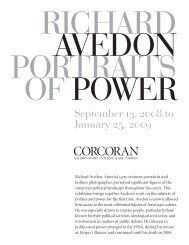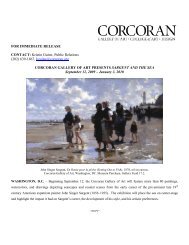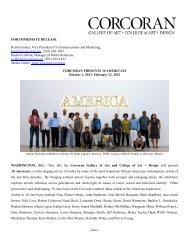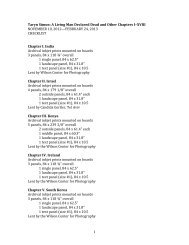Aaron Douglas, Into Bondage, 1936 - Corcoran Gallery of Art
Aaron Douglas, Into Bondage, 1936 - Corcoran Gallery of Art
Aaron Douglas, Into Bondage, 1936 - Corcoran Gallery of Art
Create successful ePaper yourself
Turn your PDF publications into a flip-book with our unique Google optimized e-Paper software.
Gordon Parks (born Fort Scott, KS, 1912–died New York, NY, 2006)<br />
American Gothic, Washington, D.C., 1942<br />
Gelatin silver print, 43 9/16 x 31 7/8 in. (81 x 110.6 cm)<br />
The Gordon Parks Collection, 1998<br />
© The Gordon Parks Foundation<br />
About the <strong>Art</strong>ist<br />
Gordon Parks is best known for his pioneering photojournalism<br />
and filmmaking which chronicle racism, poverty, crime, segregation,<br />
and other social ills through the second half <strong>of</strong> the 20th century.<br />
Parks also worked in other media, including literature, poetry, and<br />
music; in all he expressed a message <strong>of</strong> hope in the face <strong>of</strong> adversity.<br />
Born in Fort Scott, Kansas in 1912, Parks grew up in an environment<br />
<strong>of</strong> extreme poverty and racism. While working on a train as a<br />
dining car waiter in 1937, Parks came across a magazine containing<br />
images <strong>of</strong> migrant workers photographed by Farm Security<br />
Administration (FSA) photographers. He was pr<strong>of</strong>oundly moved<br />
and purchased his first camera in 1938. In January 1942, Parks<br />
moved from Chicago to Washington, D.C. to work as an intern for<br />
the FSA, focusing his camera on African American life in the city.<br />
Upon his arrival, Parks found that Washington was still segregated,<br />
and he used his camera as a weapon to fight the bigotry he<br />
witnessed. He created portraits <strong>of</strong> African Americans at work<br />
and on the street, as well as families in their homes and churches.<br />
Parks continued his photographic career with the Office <strong>of</strong> War<br />
Information and Standard Oil <strong>of</strong> New Jersey in the 1940s, and<br />
became the first African American staff photographer for Life<br />
magazine in 1947. In 1963 Parks wrote The Learning Tree, a novel<br />
about his childhood in Kansas, and he later directed an awardwinning<br />
feature film <strong>of</strong> the same subject. Through the 1980s,<br />
Parks continued his work with film as well as musical compositions.<br />
The <strong>Corcoran</strong>’s Gordon Parks Collection Archives is the result<br />
<strong>of</strong> a 1998 gift <strong>of</strong> 227 photographs from Parks.<br />
About the <strong>Art</strong><br />
American Gothic, Washington D.C. portrays Ella Watson, a government<br />
charwoman working at the Farm Security Administration.<br />
Economist Roy Stryker, Parks’ supervisor at the FSA, suggested<br />
that he should learn about life in Washington before photographing<br />
the city. Before long, he had been refused service at a movie theater,<br />
a department store, and a lunch counter. He used these experiences<br />
to inform his work when he met and photographed Watson, exploring<br />
her role at the FSA as well as her place in society. Parks took<br />
numerous photographs <strong>of</strong> Watson and her family, and she became<br />
one <strong>of</strong> his most important subjects. Parks considers American<br />
Gothic, Washington, D.C.—now an icon <strong>of</strong> American culture—his<br />
first and one <strong>of</strong> his most significant pr<strong>of</strong>essional photographs.<br />
Parks fashioned this image after Grant Wood’s 1930 painting,<br />
American Gothic, which depicts a farm couple posed in front <strong>of</strong> their<br />
house and barn. In Parks’ photograph, Watson, like the farmer, looks<br />
directly at the viewer; her broom and mop take the place <strong>of</strong> the<br />
farmer’s pitchfork. By filling the background with the American<br />
flag—in place <strong>of</strong> the farmhouse seen in Wood’s picture—and posing<br />
the somber yet dignified Watson in the foreground with her tools,<br />
Parks suggests that Watson does not share the freedom symbolized<br />
by the flag. For Parks and other African Americans living in a<br />
segregated society, freedom could not be found in a nation “riddled<br />
by fear and poverty.” The photograph provides a stark look at<br />
the pre-Civil Rights era in America, directly through the eyes <strong>of</strong><br />
a photographer who had not only experienced poverty and<br />
racism, but knew how to depict it on film.<br />
Suggested Dialogue<br />
• What message do you think Parks was trying to convey in the<br />
photograph?<br />
• Do you think Parks’ image <strong>of</strong> Ella Watson is understood today<br />
in the same way it was in 1942?<br />
• How important is the American flag to the composition?<br />
• If Watson were posed in front <strong>of</strong> a door, wall, or another part<br />
<strong>of</strong> the <strong>of</strong>fice, how would it impact the photograph?<br />
• Can you think <strong>of</strong> other memorable photographs that include<br />
the American flag?<br />
• Imagine that Parks had created a painting rather than<br />
a photograph <strong>of</strong> Watson. Would that change your interpretation<br />
<strong>of</strong> the image?<br />
• Washington, D.C. is part <strong>of</strong> the title <strong>of</strong> Parks’ photograph.<br />
Do you think similar images could have been recorded<br />
in cities other than D.C. in 1942? What about today?<br />
Extended Dialogue<br />
• Gordon Parks used this image <strong>of</strong> Ella Watson to express how<br />
he felt about the racial bigotry he experienced in Washington, D.C.<br />
If you were to create a visual depiction showing what you<br />
experience day-to-day, what would you select? Would you<br />
choose a problem or an advantage in your city, or perhaps<br />
an issue that affects the entire country?<br />
Vocabulary<br />
Photojournalism: Photojournalism is a<br />
particular form <strong>of</strong> journalism that collects<br />
and creates photographic images in order<br />
to tell a news or feature story. Photojournalism<br />
is distinguished from other kinds <strong>of</strong><br />
photography by the qualities <strong>of</strong> timeliness,<br />
objectivity, and narrative.<br />
Farm Security Administration: The Farm<br />
Security Administration, or FSA, was a<br />
federal agency created to help fight rural<br />
poverty during the Great Depression by<br />
assisting poor farmers to gain access to<br />
workable land. The Information Division<br />
<strong>of</strong> the FSA, directed by Roy Stryker, employed<br />
many great photographers to help<br />
document and publicize, growing poverty,<br />
the dust bowl landscape, the resettlement<br />
<strong>of</strong> farmers, and the ongoing work <strong>of</strong> the<br />
FSA between 1935 and 1942.<br />
Charwoman: A woman employed to clean<br />
either houses or <strong>of</strong>fice buildings.<br />
Grant Wood: Grant Wood is an American<br />
artist, best known for his Regionalist<br />
paintings <strong>of</strong> the Midwest. He primarily<br />
worked in Iowa, depicting images <strong>of</strong> rural<br />
America. He made four trips to Europe,<br />
and was very influenced by Northern<br />
Renaissance art. His most famous work<br />
is American Gothic from 1930.<br />
American Gothic: American Gothic was<br />
painted in 1930 by artist Grant Wood.<br />
It remains one <strong>of</strong> the most famous paintings<br />
in American art today. Reworked,<br />
parodied, and satirized by many artists,<br />
American Gothic depicts an farming<br />
couple in Iowa standing in front <strong>of</strong> their<br />
Gothic Revival house.<br />
Background: The part <strong>of</strong> the picture plane<br />
that seems to be farthest from the viewer.<br />
Foreground: The part <strong>of</strong> a two-dimensional<br />
artwork that is nearest to the viewer or in<br />
the front.<br />
Great Depression: The Great Depression<br />
occurring during the 1930s. It originated<br />
in the U.S., beginning with the crash <strong>of</strong> the<br />
stock market in 1929. Prices skyrocketed<br />
as did unemployment, and the country’s<br />
economy did not truly recover until the<br />
United States entered World War II in<br />
late 1941.<br />
Regionalism: Regionalism is an American<br />
art movement that became prominent<br />
during the 1930s. Regionalist artists—<br />
shunning the use <strong>of</strong> abstract and<br />
modernist forms—created scenes <strong>of</strong><br />
rural life and the countryside.<br />
Support for <strong>Art</strong>s 101 materials is made possible in part by the Women’s Committee <strong>of</strong> the <strong>Corcoran</strong> and the DC Commission on the <strong>Art</strong>s and Humanities.


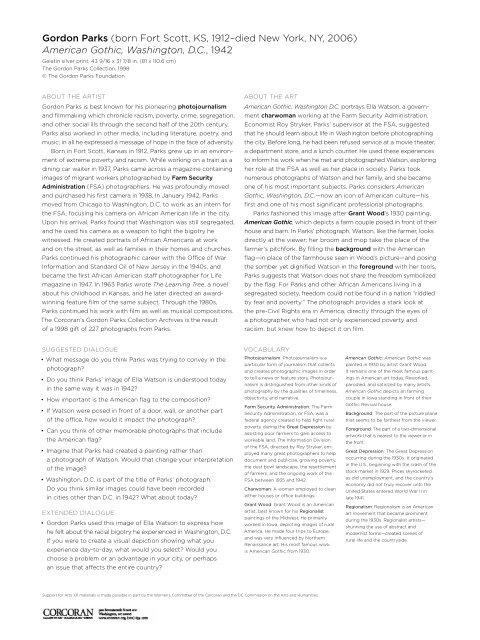
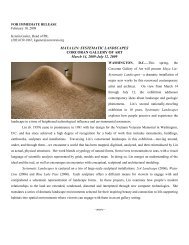
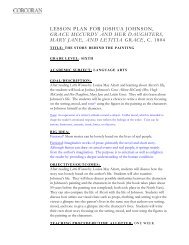
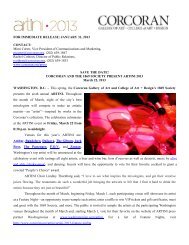


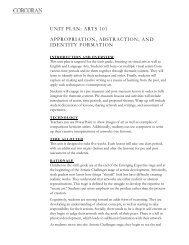
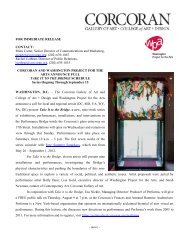

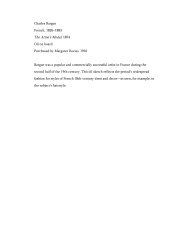
![[PDF] Ellen Harvey: The Alien's Guide to the Ruins of Washington, DC](https://img.yumpu.com/32942537/1/190x190/pdf-ellen-harvey-the-aliens-guide-to-the-ruins-of-washington-dc.jpg?quality=85)
